|
|
SOVIET AND NAZI OCCUPATION
REGIMES |
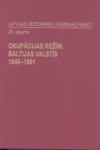 |
Okupācijas
režīmi Baltijas valstīs
1940–1991: Latvijas Vēsturnieku komisijas 2008. gada pētījumi un
starptautiskās konferences materiāli, 2008. gada 30.–31.
oktobris, Rīga.
[Symposium of the Commission
of the Historians of Latvia. Volume 25: Occupation Regimes in the
Baltic States 1940–1991. Research of the Commission of the
Historians
of Latvia, 2008 and Proceedings of the International Conference
„Occupation Regimes in the Baltic States (1940–1990):
Research results
and problems”, 30–31 October 2008, Riga] –
Rīga: Latvijas vēstures institūta apgāds, 2009. – 747 lpp.
(Latvijas
Vēsturnieku komisijas raksti, 25. sēj.).
CONTENTS
Preface. – P. 11.
Research of the Commission of the Historians of Latvia, 2008
SOVIET OCCUPATION IN LATVIA (1940–1941)
Daina Bleiere
Formation of Latvian Soviet Nomenklatura in 1940–1941. – P.
17.
Aigars Urtāns
Soviet Censorship in Latvia until 1990. – P. 50.
Jānis Viļums
The Latvian National Legion – An Anti-Soviet Underground
Organisation in Latvia from 1940 to 1941. – P. 77.
Inesis Feldmanis
Die Nachumsiedlung der Deutschbalten aus Lettland im Jahre 1941.
– P. 100.
Kārlis Dambītis
Repressions against Officers of the 24th Territorial Corps: Camp of
Lake Lama in Norilsk. – P. 117.
NAZI OCCUPATION INLATVIA (1941–1945)
Kārlis Kangeris
Staatsrechtliche,
Staatsbürgerschaft- und Eigentums-Fragen in Lettland während
der
deutschen Okkupationszeit (1941–1945). – P. 137.
Dzintars Ērglis
Murder of Jews in the Jewish Cemetery of Krustpils in Summer 1941.
– P. 173.
Kārlis Kangeris,
Uldis Neiburgs, Rudīte Vīksne
Das Lager Salaspils: historische Quellen und historiographisches
Material. – P. 200.
Uldis Neiburgs
The Latvian Central Council in Nazi-Occupied Latvia (1943–1945):
Current Issues and Results of Research. – P. 235.
Ojārs Stepens
Soviet Propaganda in Latvia at the End of the War between Germany and
USSR. July 1944 – May 1945. – P. 280.
SOVIET OCCUPATION IN LATVIA (1944–1990)
Ēriks Jēkabsons
Polish Participation in the National Resistance Movement in Latvia in
1944−1950. – P. 311.
Ginta Brūmane
Totalitarian Iconography: The Political Poster in the Soviet Latvia,
1945–1965. – P. 327.
Antonijs Zunda
The
Issue of the Baltic States and the Western Countries in the
International Relations of the Initial Phase of Détente
(1963–1969). –
P. 354.
Aleksandrs Ivanovs
Historiography of the Latvian SSR in the Period of Revival of
Latvia’s Independence (1987–1990). – P. 385.
Jānis Taurēns
Restoration of the Latvian Independence in 1988−1991: Issues of
Foreign Affairs. – P. 410.
Aija Kalnciema
Der
eigentliche Wiederaufbau der staatlichen Unabhängigkeit Lettlands
im
Zeitraum vom 4. Mai 1990 bis zum 21. August 1991. – P. 434.
OCCUPATION REGIMES IN THE BALTIC STATES (1940–1990): RESEARCH
RESULTS AND PROBLEMS
Reports of the International Conference, 30–31 October 2008
OCCUPATION OF THE BALTIC STATES: THEORETICAL ASPECTS AND HISTORIOGRAPHY
Inesis Feldmanis
The Occupation of Baltic States: Aspects of History and International
Law. – P. 459.
Heinrihs Strods
On the Road to the History of the 20th Century Occupation of the Baltic
States. – P. 468.
Erwin
Oberländer
Conflicting
Cultures of Remembrance of the Occupation of the Baltic States,
1940–1991, in Russia, Latvia and the West. – P. 480.
Boris Sokolov
The Soviet regimes in the Baltic States in the modern Russian
historiography. – P. 487.
Ronaldas Racinskas
Separate Historical Memories. Different Perceptions of Nazi and Soviet
Crimes. – P. 495.
Raimonds Cerūzis
Das Besatzungsproblem Lettlands in der deutschbaltischen Publizistik
nach dem 2. Weltkrieg. – P. 507.
Jānis Taurēns
The Third Awakening of Latvia: Issues of Research. – P. 520.
John Hiden
Paul Schiemann − Enemy of all Totalitarianism. – P. 536.
NAZI OCCUPATION IN THE BALTIC (1941–1945): CONCEPTUAL APPROACH
AND EVALUATIONS
Kārlis Kangeris
Staatsbürgerschaft
und Eigentum – rechtliche und staatsrechtliche Fragen
während der
deutschen Okkupationszeit (1941–1944): die lettische
Handelsflotte. –
P. 547.
Uldis Neiburgs
Representation of the Nazi German
Occupation in the Documents of the Latvian Central Council
(1943−1945):
Analysis of Sources and Their Content. – P. 562.
Juris Pavlovičs
Change of Occupying Powers in Vidzeme and Southern Estonia during
Summer 1941: Similarities and Differences. – P. 576.
Edvīns Evarts
Verwaltungsvereinfachung im Generalbezirk Lettland 1942–1944.
– P. 581.
Jevgenii Greben
Review
of Documents on the History of the Reich Commissariat Ostland in the
Archives of the Republic of Byelorussia. – P. 589.
THE FIRST AND THE SECOND SOVIET OCCUPATION (1940–1941,
1945–1990): SOVIETIZATION AND ITS CONSEQUENCES
Daniel Boćkowski
“Together Forever”: The Soviet Occupation of Eastern Poland
during the Second World War. – P. 599.
Juris Ciganovs
Preparation of the Red Army for Invasion into the Baltic States in June
1940. – P. 617.
Antonijs Zunda
Western
Countries and the Problem of the Occupied Baltic States at the
Beginning of the Post-war Period (1945–1953). – P. 622.
Olaf Mertelsmann
Searching for Reasons of the Forced Collectivization in the Baltic
Republics. – P. 634.
Gatis Krūmiņš
Organisation
of Territorial Administration and the Policy of Selection of the
Leading Staff in Latvia 1944–1947. – P. 641.
Ritvars Jansons
Soviet Repressions in the Occupied Latvia in 1944–1945. –
P. 665.
Veronika Sajadova
Deportation in 1949 as a Basis of Sovietization of Latvian Agriculture.
– P. 672.
Jelena Zubkova
“A
Different USSR”? Peculiarities of the Implementation of the
Soviet Project in the Baltic States (1950s–1960s). – P. 677.
Ilgvars Butulis
A Few Expressions of National Communism in Magazine Zvaigzne
(1956–1959). – P. 696.
Ainārs Bambals
Operation
of Exterminator Battalions of the Ministry of State Security of the
Latvian SSR (1944–1955) – Example of the History of
Collaborationism. –
P. 709.
Argita Daudze
Latvian Exile Community in Sweden and Soviet Struggle against it in the
1970s–1980s. – P. 721.
Aron Shneyer
Jewry and Soviet Power in the Baltic Countries in 1945–1990.
– P. 733.
Authors of the Articles Published in this Collection. – P. 746. |
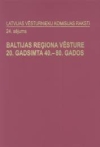 |
Baltijas reģiona
vēsture 20. gadsimta
40.–80. gados: Latvijas Vēsturnieku komisijas 2007. gada pētījumi
un
starptautiskās konferences „Baltija Otrajā pasaules karā
(1939–1945)”
materiāli, 2007. gada 6.–7. novembris, Rīga. [Symposium of the
Commission of the
Historians of Latvia. Vol. 24. History of the Baltic Region of the
1940s–1980s: Research of the Commision of the Historians of
Latvia,
2007 and Proceedings of an International Conference „Baltic
during the
Second World War (1939–1945)”, 6–7 November 2007,
Riga] – Rīga: Latvijas
vēstures institūta apgāds, 2009. – 599 lpp. (Latvijas Vēsturnieku
komisijas raksti, 24. sēj.).
ISBN 978-9984-824-09-3
CONTENTS
Preface. – P. 11.
Research of the Commission of the Historians of Latvia, 2007
SOVIET OCCUPATION IN LATVIA (1940–1941)
Inesis Feldmanis
Germany’s attitude towards the Occupation and Sovietisation of
Latvia (1940–1941). – P. 17.
NAZI GERMANY OCCUPATION IN LATVIA (1941–1945)
Juris Pavlovičs
Latvian District Authorities during the Introduction of the Nazi German
Civilian Rule. – P. 47.
Kārlis Kangeris
Die
Lettische Legion – ein Diktat der deutschen Besatzungsmacht oder
Erfüllung lettischer “Hoffnungen”? – P. 62.
Uldis Neiburgs
Resistance
Movement in Latvia under National-Socialist German Occupation
(1941–1945): Less Studied Aspects and Their Perception Nowadays.
– P.
98.
SOVIET OCCUPATION IN LATVIA (1944–1990)
Antonijs Zunda
The
Baltic Issue and Western States in the Period of First Postwar
Political Thaw and New Tensions from 1954 till 1961. – P. 139.
Aleksandrs Ivanovs
The
History of Latvia in the 1960s – Middle of 1980s: The Course of
Investigation, Results, and Prospects (A Historiographic Overview).
–
P. 188.
Gatis Krūmiņš
Agricultural Policy in Latvia: 1985–1989. – P. 242.
BALTIC DURING THE SECOND WORLD WAR (1939–1945)
Proceedings of an International Conference, 6–7 November 2007
FOREIGN POLICY OF THE BALTIC STATES (1939–1940): SEARCH OF NEW
APPROACHES AND ALTERNATIVES
Jānis Taurēns
Latvian Foreign Policy in 1938–1940: Problems of the
historiography. – P. 271.
Ilgvars Butulis
Die Wiederspiegelung des Zweiten Weltkrieges in den lettischen
Militärzeitschriften (1939–1940). – P. 289.
Jānis Ķeruss
Die Neutralität Lettlands zu Beginn des 2. Weltkriegs:
Vorstellungen und Realität. – P. 303.
Argita Daudze
Assessment of the Situation in Latvia in 1939–1940 by the Swedish
Diplomatic Missions. – P. 320/
Kārlis Kangeris
Die
geheimen deutsch-sowjetischen und schwedisch-sowjetischen Verträge
des Jahres 1941 über die baltischen Staaten. – P. 332.
OCCUPATION OF LATVIA, LITHUANIA AND ESTONIA IN 1940: STATE OF RESEARCH
AND PROSPECTS
Juris Ciganovs
Confiscation of the Latvian Army’s Materials, Equipment and
Property after the Soviet Occupation in 1940. – P. 345.
Olaf Mertelsmann
Transition to Command Economy and Economic Exploitation: The Experience
of Estonia 1940–1941. – P. 349.
Rasa Pārpuce
Kulturgüter der deutschen Umsiedler im Baltikum vom Juni 1940 bis
Juni 1941. – P. 376.
Aigi Rahi-Tamm
Fulfilling
“Special Tasks” in the Soviet Rear. Activity of the
Department of Archives in 1941–1944. – P. 384.
Antonijs Zunda
Great
Britain between de facto and de iure Concerning the Issue of
Recognizing the Occupation and Annexation of the Baltic States in the
Initial Stage of the Second World War (1940–1941). – P. 400.
GERMAN OCCUPATION TIME IN THE BALTIC: COMPARATIVE ANALYSIS, RESEARCH
PROBLEMS AND SOLUTIONS
Inesis Feldmanis
Lettland im Zweiten Weltkrieg: die aktuellen Forschungsprobleme.
– P. 419.
Boris Sokolov
The Baltic States during the Second World War in the Public Opinion of
Modern Russia. – P. 432.
Uldis Neiburgs
Resistance
Movement in the Nazi-Occupied Baltic States (1941–1945):
Theoretical Problems and Practical Solutions. – P. 440.
Kaspars Zellis
The
Topic of Liberation and Freedom in the Propaganda of the Occupational
Power: the Case of Latvia during the Nazi Occupation (1941–1945).
– P.
455.
Toomas Hiio
German Military Authority of the Army Group
“North” on the Estonian Territory in 1941–1944:
German Military
Occupation in Estonia within the Scope of the Hague Convention
“Laws
and Customs of War on Land”. – P. 465.
Arūnas Bubnis
Lithuanian Police Battalions in Latvia (1944–1945). – P.
481.
Arkadiusz Adamczyk
The
Baltic States and the Baltic Sea Region in Geopolitical Concepts of the
Piłsudski Adherents during the Second World War. – P. 488.
Andriejus (Andrius)
Stoliarovas
The 12th Lithuanian Police Battalion during the Second World War
(1941–1945). – P. 503.
Jevgenij Greben
Some Aspects of the Daily Life of the Population of Ostland (a Case
study of Belarus General Province). – P. 520.
Viktors Duks
The Second World War in Latvia: Contributions and Opportunities of
Military Archaeology. – P. 530.
Heinrihs Strods
Die kämpfenden Aktivisten der UdSSR in Lettland (1941–1945).
– p. 540.
BALTIC WARRIORS ON
THE FRONT-LINES OF THE SECOND WORLD WAR: NEW SOURCES AND RESEARCH
POSSIBILITIES Ilze Jermacāne
Red
Army, 201st Latvian Riflemen Division (August 1941 – October
1942) in
Latvia State Archive’s Documents: Sources, Information and
Significance. – P. 549.
Valdis Kuzmins
The 15th Latvian SS
Voluntary Division in the Positions at the River Velikaya (1 March
– 14
April 1944): Analysis of Losses. – P. 570.
Darjušs
Roguts
Latvians in Soviet Screening-Filtration Camps after the Second World
War. – P. 581.
Authors of the Articles Published in this Collection. – P. 598.
|
 |
Holokausta
pētniecības problēmas Latvijā: 2006.–2007. gada pētījumi par
holokaustu
Latvijā un starptautiskās konferences materiāli, 2007. gada
6.–7.
novembris, Rīga [Problems
of the Holocaust Research in Latvia. The Holocaust Studies in Latvia
2006-2007 and Proceedings of an International Conference 6-7 November
2007, Riga]. –
Rīga: Latvijas vēstures
institūta apgāds, 2008. – 375 lpp. (Latvijas vēsturnieku
komisijas raksti, 23. sēj.).
Papers in Latvian or
Russian, with summaries in English or German.
CONTENTS
Preface.
– P. 9.
Aivars Stranga
In
Place of Introduction. Commemorating the Contribution of Professor
Rauls Hilbergs in Holocaust Research. – P. 11.
RESEARCH
ON HOLOCAUST PROBLEMS IN LATVIA
Aivars Stranga
Holocaust
in German-occupied Latvia: 1941–1945. – P. 21.
Andrievs Ezergailis
Stahlecker’s
Reports: the Basic Source and the Kkey of the History of Holocaust.
– P. 30.
Rebecca
Margolis, Edward Anders
The Linkimer Diary: How
11 Jews Survived the Holocaust. – P. 48.
Aigars Urtāns
Holocaust
in the Province of Latvia: Abrene District. – P. 72.
Aigars Urtāns
Assassination
of Jews in Madona District. – P. 95.
Aigars Urtāns
Expropriation
of Jewish Property: Ludza District and Madona District in the
German-occupied Latvia. – P. 118.
REPORTS
ON HOLOCAUST FROM THE CONFERENCE “BALTIC IN WORLD WAR II
(1939–1945)” ON 6–7 NOVEMBER 2007
Matthew Kott
What
Does the Holocaust in the Baltic States Have to Do with the
SS’ Plans for Occupied Norway? – P. 139.
Sergey Novikov
Холокост
на оккупированной территории Беларуси и Латвии (1941–1944
г.):
компаративний анализ историографии. – P. 162.
PUBLICATIONS
OF DOCUMENTS
Gabriels
Civjans – alias Gunārs Cīrulis
(translated and
prepared for publication by Andrew Ezergailis). – P. 177.
Use
of Jewish Workforce during the Liquidation Stage of the Riga Ghetto
(translated
and prepared for publication by Kārlis Kangeris). – P. 186.
COMPILATION
BY INVESTIGATORS OF THE LOCAL HISTORY
Josifs Ročko
From
the History of Holocaust in Daugavpils. – P. 213.
Josifs Ročko
It
Happened in Preiļi. – P. 240.
Uldis Lasmanis
Holocaust
in the Town of Jēkabpils. – P. 260.
Uldis Lasmanis
Victims
and Survivors of Holocaust in Jēkabpils. – P. 287.
MEMORIES
Jānis Britāns
No
More Witnesses... – P. 331.
Memories about the Fate
of Latgale Jewish Refugees in 1941–1945
(prepared
for publication by Josifs Ročko). – P. 340.
|
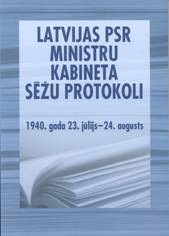 |
Latvijas
PSR Ministru kabineta sēžu protokoli: 1940. gada 23.
jūlijs–24.
augusts [Minutes of the Meetings of the Cabinet of Ministers of the
Latvian SSR: 23 July - 24 August 1940]. – Rīga:
Latvijas vēstures institūta apgāds, 2008. – 319 lpp.
Text in Latvian.
|
 |
Ārvalstu arhīvu
dokumenti par
okupācijas režīmu politiku Latvijā 1940–1968: Dokumentu
krājums [Documents from Foreign Archives on the Policy of Occupation
Regimes in Latvia 1940-1968. Collection of Documents]. – Rīga:
Latvijas vēstures institūta
apgāds, 2008. – 382 lpp. (Latvijas Vēsturnieku komisijas
raksti, 22. sēj.).
Text in English, German, Russian and Latvian.
CONTENTS
INTRODUCTION.
– P. 7.
THE FIRST YEAR OF SOVIET
OCCUPATION. 1940–1941
The Soviet
Government’s
Plans in the First Year of Occupation. – P. 17.
USA,
Great Britain and the Occupation of the Baltic States. – P.
47.
OCCUPATION OF NAZI GERMANY.
1941–1945
Intentions
of Nazis’, the Situation and Mood in Latvia.
1941–1943. – P. 73.
Latvian
Self-Administration of the Land. 1942–1945. – P.
93.
Latvian SS Volunteer Legion. 1942–1943.
– P. 156. lpp.
Nazis’ Attitude towards
Latvian Statehood and the Autonomy Question. 1941–1943.
– P. 173.
Great Britain, USA and the Baltic
Question. – P. 190.
LATVIA AS
A PART OF THE SOVIET UNION. 1945–1968
Struggle
of the USSR Occupation Regime against Armed Resistance in Latvia,
Lithuania and Estonia. 1946–1952. – P. 201.
The
Policy Realized by the Soviet Regime towards Church.
1945–1947. – P. 277.
USA, Great Britain
and the Baltic Question. 1946–1950. – P. 337.
Great
Britain and the Gold of the Baltic States. 1965–1968.
– P. 361.
THE LIST OF
PUBLISHED DOCUMENTS. – P. 371.
ABBREVIATIONS
OF ARCHIVE NAMES. – P. 381.
COMPILERS OF
THE COLLECTION. – P. 382.
|
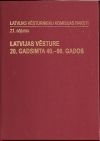 |
Latvijas vēsture 20. gadsimta
40.-90. gados: Latvijas Vēsturnieku komisijas 2006. gada pētījumi.
[History of Latvia of the 1940s-1990s. Research of the Commission of
the Historians of Latvia] – Rīga: Latvijas
vēstures institūta apgāds,
2007. – 503. lpp. (Latvijas Vēsturnieku komisijas raksti, 21.
sēj.).
Papers in Latvian with summaries in English or German.
CONTENTS
Introduction.
– P. 9.
SOVIET
OCCUPATION IN LATVIA (1940–1941)
Gints Zelmenis
Supervision
of Culture and Censorship in Latvia during the Soviet Occupation,
1940–1941. – P. 15.
NAZI
GERMANY OCCUPATION IN LATVIA (1941–1945)
Inesis Feldmanis
Nazi
Occupation Policy in the Baltic (1941–1945): Conception and
Manifestations. – P. 47.
Kaspars Zellis
National
Socialist Germany Propaganda in the Occupied Latvia,
1944–1945. – P. 61.
Kārlis Kangeris
Die Rückkehr und der Einsatz der
Deutschbalten im Generalbezirk Lettland 1941–1945.
– P. 84.
Uldis
Neiburgs
Association
of the Participants of the Latvian Resistance Movement (LPKDA) and Its
Documentation about the Resistance Movement in Nazi-Occupied Latvia
(1941–1945). – P. 122.
Andris
Kūla
Metropolitan Sergiy and the Orthodox
Church in
Nazi-Occupied Latvia (1941–1944). – P. 171.
Kārlis
Kangeris, Uldis Neiburgs, Rudīte Vīksne
Das
Lager Salaspils im nationalsozialistischen administrativen System und
in der wissenschaftlichen Typologie der Straflager
(1941–1942). – P.
216.
SOVIET OCCUPATION IN LATVIA
(1944–1990)
Juris Pavlovičs
Soviet Re-occupation of Latvia
1944–1946. A Historiographic Review. – P. 253.
Antonijs
Zunda
The Baltic Issue and the Western
Countries: End of
the 1940s – Beginning of the 1950s. – P. 271.
Aleksandrs
Ivanovs
Soviet
Policy in Latvia in the Second Half of the 1950s – Middle of
the 1980s:
The Course of Investigation, Results, and Prospects (A Historiographic
Overview). – P. 305.
Daina
Bleiere
Membership, Ethnic and Social
Composition of the
Latvian Communist Party Organization in 1944–1949.
– P. 356.
Ainārs
Bambals
Commanders
and Recruited Personnel of the Exterminators Battalions of the Latvian
SSR Ministry of State Security (1944–1954): Structural
Analysis. – P.
374.
Ritvars
Jansons
Prosecution for Antisoviet Propaganda
and
Agitation in the USSR and Latvian SSR, 1953–1967. –
P. 401.
Heinrihs
Strods
Censorship of Exile Literature in the
Latvian SSR
(1958–1990). – P. 425.
Ilgvars
Butulis
Ausländische Informationen in
der
Zeitschrift “Zvaigzne” (1956–1959).
– P. 452.
COLLECTION OF REGIONAL STUDIES
Irēna
Šaicāne
Youth
Unviolent Resistance Organizations in Viļaka in 1945. – P.
475.
Authors of the Articles Published in
this Collection. – P. 502.
|
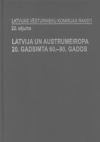 |
Latvija
un Austrumeiropa 20. gadsimta 60.–80. gados: Starptautiskās
konferences referāti, 2006. gada 10. oktobris, Rīga [Latvia and Eastern
Europe in the 1960s-1980s].
– Rīga: Latvijas vēstures institūta apgāds, 2007. –
227 lpp. (Latvijas Vēsturnieku komisijas raksti, 20. sēj.).
Papers in Latvian or English, with summaries
in English.
CONTENTS
Preface. – P. 9.
Opening Address of the President of the Republic of Latvia Vaira
Vīķe-Freiberga to the Participants of the Conference. – P.
13.
Antonijs
Zunda
The Baltic Issue in the International Relations during the 1960s.
– P. 17.
Aleksandrs
Ivanovs
National Policy in Latvia during the 1960s–1980s: Theoretical
Approaches, Concepts, Research Contexts. – p. 30.
Li
Bennich-Björkman
Between Resistance and Opposition: Developments after Stalinism.
– P. 45.
Arvydas
Anušauskas
KGB and the System of Controlling Society. – P. 73.
Saulius
Grybkauskas
The Soviet dopusk System as Society Control Lever in the Industry of
Soviet Lithuania during 1965–1985. – P. 79.
Heinrihs
Strods
Censure of Exile Publications in the Latvian SSR (1958–1989).
– P. 87.
Valters
Nollendorfs
Exile Literary Contacts with Latvia and the Foundation of the Latvian
Writers’ Association in the 1970s. – P. 96.
Ritvars
Jansons
The Soviet Union’s Struggle against “Ideological
Diversion
of Capitalist Countries” (1967–1989). –
P. 107.
Jānis
Rimšāns
Manifestations of Youth Resistance against the Communist Regime in the
Latvian SSR (1965–1985). – P. 116.
Nikandrs
Gills
Religious Minorities in Latvia under Communist Regime in the
1940s–1980s. – P. 133.
Māra
Zirnīte
Oral History Testimonies in Comparison with the Press during the
1960s–1980s. – P. 146.
Irēna
Saleniece
Use of Oral History Sources in Researching Latvian History during the
1960s–1980s: Religious Life. – P. 156.
Edmunds
Šūpulis
The Politics of Memory: Judgments of the Latter Stage of Socialism in
Life-Stories. – P. 166.
Ilga
Kreituse
The Role and Activities of the Latvian Political Elite after the July
1959 Plenum of the CC of the CPL. – P. 172.
Juris
Ciganovs
The Influence of the Soviet Ideology on Museums Activities in Latvia
during the 1940s–1960s. – P. 179.
Dorina
Orzac
Adaptation or Transformation: the Dej Regime after 1960 in Romania.
– P. 185.
Anatolyi
Rusnachenko
Ukraine from the mid-1950s to the mid-1980s: The Second among Equals or
a Colony of the Empire? – P. 193.
Alfred
Senn
“Sport – ty mir”. – P. 205.
BIBLIOGRAPHICAL INDEX OF THE SYMPOSIUM OF THE COMMISSION OF THE
HISTORIANS OF LATVIA (VOL. 16–20). – P. 213.
AUTHORS OF THE ARTICLES PUBLISHED IN THIS COLLECTION. – P.
226.
|
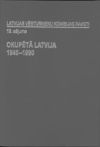 |
Okupētā Latvija,
1940–1990: Latvijas Vēsturnieku komisijas 2005. gada pētījumi
[Occupied Latvia, 1940-1990].
– Rīga: Latvijas vēstures institūta apgāds, 2007. –
507 lpp. (Latvijas Vēsturnieku komisijas raksti, 19. sēj.)
Papers in Latvian, with summaries in English or
German.
CONTENTS
Introduction. – P. 9.
SOVIET OCCUPATION IN LATVIA (1940–1941)
Aleksandrs
Ivanovs
National Resistance in Latvia (1940s–1980s) in Latvian
Historiography. – P. 27.
Antonijs
Zunda
Mutual Financial Claims between the UK and USSR, and Latvia’s
Gold. – P. 71.
Ojārs
Stepens
Soviet Propaganda in Latvia at the beginning of the War between Germany
and the USSR, 22 June–8 July 1941. – P. 99.
NAZI GERMANY OCCUPATION IN LATVIA
(1941–1945)
Inesis
Feldmanis
German Occupation Policy in the Baltic (1941–1945): General
Tendencies and Specifics. – P. 121.
Juris
Pavlovičs
Change of the Occupying Powers Zemgale in the Summer of 1941: Jelgava
District (end of June – beginning of July 1941). –
P. 134.
Heinrihs
Strods
Literature and Sources on USSR Combatants in Latvia,
1941–1945. – P. 153.
Kārlis
Kangeris
Untersuchungen zum “Jahr des Grauens”
während der
deutschen Besatzungszeit: Geschichte zwischen Wissenschaft und
Propaganda. – P. 190.
Kaspars
Zellis
Propaganda of National Socialist Germany in the Occupied Latvia,
1942–1943. – P. 219.
SOVIET OCCUPATION IN LATVIA (1944–1990)
Ritvars
Jansons
People’s Commissariat of State Security of the Latvian SSR,
1944–1945. – P. 251.
Ainārs
Bambals
Exterminator Battalions of the Ministry of State Security of the
Latvian SSR (1944–1956). – P. 277.
Dzintars
Ērglis
Von sowjetischen Repressivorganen verhaftete Aktivisten und
Unterstützer des Lettischen Zentralrates
(1944–1953): eine
Strukturanalyse. – P. 323.
Raitis
Ābelnieks, Aigars Urtāns
Die nationale Widerstandsbewegung und die Gegenmaßnahmen der
sowjetischen Besatzungsmacht in der Umgebung von Bauska (von 1944 bis
Mitte der 1950er Jahre). – P. 356.
Jānis
Stradiņš
Treatment of Scientists and Academy Circles in Soviet Latvia by
Stalinist Regime (1944–1953). – P. 408.
Aldis
Bergmanis, Indulis Zālīte
Committee of State Security (KGB) of the Latvian SSR and the
Ideological Control of the Society (1965–1990). –
P. 449.
REPORT OF THE LATVIAN COMMISSION OF HISTORIANS
Inesis
Feldmanis
Nazi Occupation Policy in Latvia: Research Results (report delivered in
the 3 July 2006 meeting of the Latvian Commission of Historians).
– P. 503.
Authors of the Articles Published in this Collection. – P.
506.
|
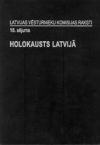 |
Holokausts
Latvijā:
Starptautiskās konferences materiāli, 2004. gada 3.–4.
jūnijs, Rīga, un
2004.–2005. gada pētījumi par holokaustu Latvijā [Holocaust
in Latvia].
– Rīga: Latvijas vēstures
institūta apgāds, 2006. – 383. lpp. (Latvijas Vēsturnieku
komisijas raksti, 18.
sēj.).
Papers
in Latvian and English, with summaries in English.
CONTENTS
Preface.
– P. 9.
CONFERENCE “TOTALITARIAN
REGIMES IN THE BALTIC: RESEARCH RESULTS AND PROBLEMS” ON JUNE
3–4, 2004
REPORTS
ON THE HOLOCAUST
Aivars
Stranga
Research
and Memory of the Holocaust in Latvia. – P. 13.
Emmanuel
Zingeris
Reports
on the Nazi Occupation in Lithuania Made by the Lithuanian
International
Historical Commission. – P. 33.
Andrievs
Ezergailis
Knowledge
of the Holocaust in 1941. – P. 38.
Josifs
Ročko
Extermination
of Jews in Ilūkste District in 1941 (Recollections of the Local
Residents). –
P. 49.
ISSUES
OF THE HOLOCAUST RESEARCH IN LATVIA
Andrievs
Ezergailis
Six
Versions of the Holocaust in Latvia. – P. 65.
Grigorijs
Smirins
Jews
of Riga in the Period of the Nazi Occupation (1941–1944).
– P. 83.
Aigars
Urtāns
Assassination
of Jewish Civilians in Kuldīga District. – P. 118.
Eva
Treiģe-Treide, Ēriks
Prokopovičs, Andis
Jēkabsons
Destiny
of the Jews Community and
Expropriation of Jews’ Property in the Town of Valdemārpils.
– P. 137.
Andris
Tomašūns
Jews
murdered in Jelgava: Soviet and Nazi data. – P. 162.
Dzintars Ērglis
Holocaust
im Amtsbezirk Kreuzburg im Sommer 1941: Siedlungen Piejūti und Smani.
– P. 185.
Rudīte
Vīksne
Extermination
of Jews in Latvian Towns: Problems and Research Results. – P.
217.
COLLECTION
OF REGIONAL STUDIES
Uldis
Lasmanis
Holocaust
in the Town of Viesīte. – P. 239.
Uldis
Lasmanis
Holocaust
in the Parishes of the Jēkabpils District. – P. 273.
TESTIMONY
OF THE SURVIVOR
Memories
of Elmārs Rivošs (fragment). – P. 313.
Authors
of the Articles Published in this Collection. – P. 382.
|
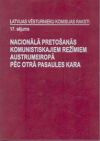 |
Nacionālā
pretošanās komunistiskajiem režīmiem Austrumeiropā pēc Otrā
pasaules kara:
Starptautiskās konferences materiāli, 2005. gada 7.–8.
jūnijs, Rīga [National Resistance to Communist Regimes in Eastern
Europe after World War II]. – Rīga:
Latvijas vēstures institūta apgāds, 2006. – 287 lpp.
(Latvijas Vēsturnieku
komisijas raksti, 17. sēj.).
Papers in Latvian or English, with summary in
German.
CONTENTS
Letter by Vaira
Vīķe-Freiberga, President of the Republic of Latvia, on the opening of
the
International Conference of the historians “National
Resistance to Communist
Regimes in Eastern Europe after World War II”. – P.
9.
Introduction. – P. 11.
MATERIALS OF THE
CONFERENCE
Heinrihs Strods
The National and
Soviet Partisans in the Baltic States (1941–1956):
Similarities and
Differences. – P. 19.
Boris
Sokolov
Postwar Resistance
Movement in the Soviet Union and Countries of Eastern Europe in Russian
Historiography. – P. 36.
Ronaldas
Račinskas
Crimes of the
Communist Regime in Lithuania after World War II and National
Resistance:
Conclusions of Lithuanian International Historical Commission.
– P. 45.
Janusz
Vróbel
Polish Resistance against the Communist Regime after World War II.
– P.
64.
Vitaly
Skalaban
Anti-Soviet Resistance in Belarus after World War II. – P.
83.
Raitis
Ābelnieks
Die Besonderheiten
des bewaffneten nationalen Widerstandes im Kreis Bauska (1944-1950).
– P. 88.
Ritvars
Jansons
Combat Operations of
the Soviet Security Agents (Chekists) against Latvian National
Partisans
(1944–1956). – P. 96.
Zigmārs
Turčinskis
The Role of
Agents-combatants in the Annihilation of the National Partisan Union of
Latvia
(1944–1953). – P. 104.
Aldis
Bergmanis
The LSSR Secret Service
Operations against the National Partisans
of Latvia in 1953. – P. 116.
Björn
M. Felder
Underground
Networking: National and International Connections of the anti-Soviet
Resistance in Latvia (1944–1950). – P. 124.
Aleksandrs
Ivanovs
National Resistance
in Latvia after World War II in Latvian Historiography (2nd half of the
1940s-2nd half of the 1980s). – P. 136.
Ainārs
Bambals
Material Evidence and
Documents in Criminal Cases of the State Security Ministry of the
Latvian SSR
as the Source of the History of the National Partisans
(1944–1956). – P. 154.
Inese
Dreimane
Oral History of the National Partisan Activities in Northern Latgale.
–
P. 178.
ORAL
HISTORY AND
DOCUMENTS
Memories
of the
Inhabitants of Northern Latgale (Commentary by Inese Dreimane).
– P. 191.
The Garrison Sites
and Operations of the Units of the 4th and 5th Divisions of the
People’s
Commissariat of the interior of the USSR in the Baltic States
1945–1951 (Editor
Heinrihs Strods). – P. 241.
The Authors of the Articles Published in this Collection. –
P. 286.
Zusammenfassung. – 537. lpp.
|
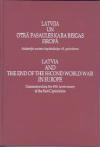 |
Latvija un Otrā pasaules kara
beigas Eiropā: Atzīmējot nacistu kapitulācijas 60. gadadienu
/ Latvia and the End of the Second World War in Europe:
Commemorating
the 60th Anniversary of the Nazi Capitulation. –
Rīga:
Latvijas
vēstures institūta apgāds, 2005. – 226 lpp.
In Latvian with summary in English.
|
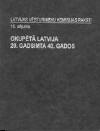 |
Okupētā Latvija
20. gadsimta 40.
gados: Latvijas Vēsturnieku komisijas 2004. gada pētījumi [Occupied Latvia
in 20th century (1940-s). Research of the Commission of the Historians
of Latvia 2004]. – Rīga: Latvijas vēstures institūta
apgāds, 2005. – 450 lpp. (Latvijas Vēsturnieku komisijas
raksti, 16. sēj.).
Papers in Latvian or English, with summaries in Latvian, English or
German.
CONTENTS
Preface.
– P. 7.
SOVIET OCCUPATION IN LATVIA
(1940–1941)
Aleksandrs Ivanovs
Historiography
of the History of Latvia on the Change of Occupation Powers in Latvia,
1940–1944/45. – P. 11.
Antonijs Zunda
The
Baltic States and Great Britain at the Beginning of World War II
(1939–1941). – P. 73.
NAZI
GERMANY OCCUPATION IN LATVIA (1941–1945)
Inesis Feldmanis
Nazi
Occupation Policy in Latvia, Lithuania and Estonia
(1941–1945): A Comparative Description. – P. 93.
Heinrihs Strods
Persecutions
of Soviet Activists in Latvia during the Years of Nazi Occupation (23
June 1941–1945). – P. 106.
Juris Pavlovičs
Change
of Occupying Powers in Rīga in Summer 1941. – P. 205.
Kaspars Zellis
The
Propaganda of Nazi Germany in the Occupied Latvia
(June–December 1941). – P. 235.
Kārlis Kangeris
Der
Aufbau der Polizei in Lettland während der deutschen
Okkupation (1941–1945). – P. 278.
Inese Dreimane
Women’s
Collaboration with Nazi Repressive Structures in Latvia from 1941 to
1944. – P. 319.
Uldis
Neiburgs
Diplomats
of the Republic of Latvia in the West and Central Council of Latvia
during 1943–1944: Political Stance, Contradictions and
Solutions.
– P. 369.
SOVIET OCCUPATION IN
LATVIA (1944–1945)
Ritvars Jansons
The
Influence of the Communist Party on the People’s Commissariat
of
the Interior of the Latvian SSR (1944–1945). – P.
395.
Jānis
Riekstiņš
Mobilisierung der Einwohner
Lettlands in die Rote Armee (1944–1945). – P. 415.
The
Authors of the Articles Published in this Symposium. – P. 450.
|
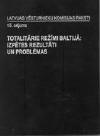 |
Totalitārie
režīmi Baltijā: izpētes rezultāti un problēmas: Starptautiskās
konferences materiāli, 2004. gada 3.–4. jūlijs, Rīga
[Totalitarian regimes in the Baltic: research findings and issues.
Materials of an International conference 3-4 June 2004, Riga]. –
Rīga: Latvijas vēstures
institūta apgāds, 2005. – 283 lpp. (Latvijas Vēsturnieku
komisijas raksti, 15. sēj.)
Papers in Latvian or English, with summaries in Latvian, English or
German.
CONTENTS
Preface.
– P. 9.
SOVIET OCCUPATION
1940–1941
Alfred Erich Senn
Baltic
Battleground. – P. 15.
Arvydas
Anušauskas
Massacre
of Military and Civilian Population Perpetrated by the Soviets.
– P. 31.
Kseniya
Petrochenko
Problems of Separated Families and
Their Adaptation to the New Situation. – P. 44.
LATVIA
UNDER THE NAZI OCCUPATION
Inesis Feldmanis
Nazi
Occupation Policy in Latvia (1941–1945): Problems of
Research, Possible Solutions and Variations. – P. 53.
Antonijs Zunda
The
Problem of the Baltic States and Great Britain during the World War II
(1939–1945). – P. 71.
Boris Sokolov
The
Baltic States in 1939–1945, in Russian Historiography:
Counter-nationalism. – P. 92.
Markku
Jokisipilä
Between
the Upper and Nether Stone. Finland and the Baltic States under
constraint of the Soviet Union and Germany (1939–1944).
–
P. 99.
Kārlis
Kangeris
Die
in den letzten zehn Jahren (1995–2004) ausserhalb Lettlands
veröffentlichten historischen Forschungsarbeiten über
die
deutsche Basatzungszeit in Lettland. – P. 126.
Juris Pavlovičs
No
Man’s Land: The Change of Occupying Powers in the Eastern
Part of
the District of Riga (28 June–6 July 1941). – P.
144.
Uldis
Neiburgs
Diplomats
of the Republic of Latvia in the West and Nazi-Occupied Latvia
(1941–1945): Sources and Research Opportunities. –
P. 154.
SOVIET OCCUPATION
1944–1959
Heinrihs Strods
Sovietisation
of Latvia (1944–1959). – P. 173.
Daina Bleiere
Post-War
Period in the Research of the Baltic States: Current Research Trends
and Problems. – P. 193.
Ritvars Jansons
The
Results and Perspectives of Research on the History of the Security
Institutions of the Latvian SSR. – P. 211.
BRIEFINGS
OF THE COMMISSION OF THE HISTORIANS OF LATVIA
Inesis Feldmanis
The
Occupation of Latvia: Some Aspects of History and International Law.
– P. 225.
Inesis
Feldmanis, Kārlis Kangeris
On Latvian Voluntary
SS Legion. – P. 236.
BIBLIOGRAPHICAL
INDEX SYMPOSIUM OF THE COMMISSION OF THE HISTORIANS OF LATVIA (VOL.
1–15). – P. 247.
The Authors of
the Articles Published in this Symposium. – P. 283.
|
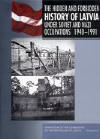 |
The
Hidden and Forbidden of Latvia under Soviet and Nazi Occupations
1940–1991: Selected Research of the Commission of the
Historians
of Latvia. – Rīga: Institute of the History of
Latvia
Publishers, 2005. – 383 pages (Symposium of the Commission of
the
Historians of Latvia, Vol. 14).
In English.
The
Hidden and Forbidden History of Latvia under Soviet and Nazi
Occupations 1940–1991 is the first major collection of
scholarly
articles by Latvian historians in English dealing with the long
occupation period. During that time much of the history of the country
and its people was indeed both hidden and forbidden. It was hidden not
only from the population, but even more – from the outside
world.
The population still had its memory, of course, and could find its way
around. The outside world, however, was shown only the
occupants’
version of history – twisted and distorted to their own ends.
That was true during the two Soviet occupations (1940–41 and
1944/45–1991) and the occupation by National Socialist
Germany in
1941, which ended in Western Latvia with the German capitulation on 8
May 1945. Neither of the occupying powers was interested in the Latvian
nation’s point of view or even documentable truth. At times
the
Communists found the Nazi version useful to their own ends, such as
regarding atrocities attributed to Latvians during World War II. It was
forbidden – and dangerous – to carry out research
that
would contradict the officially established historical point of view.
This volume attempts to clear up the view – not rewriting
history, but setting it straight.
CONTENTS
Vaira Vīķe-Freiberga
President of the
Republic of
Latvia
Foreword. – 7. lpp.
Valters
Nollendorfs, Erwin
Oberländer
Introduction. – 9.
lpp.
Alfred
Erich Senn
Baltie Battleground. – 17.
lpp.
UNDER SOVIET UNION 1940–1941
Irēne
Šneidere
The
First Soviet Occupation Period in Latvia 1940–1941.
– 33. lpp.
Irēne
Šneidere
The Occupation of Latvia in
June 1940:
A Few Aspects of the Technology of Soviet
Aggression. – 43. lpp.
Rudīte Vīksne
Soviet
Repressions against Residents of Latvia in 1940–1941: Typical
Trends. – 53. lpp.
Jānis
Riekstiņš
The
14 June 1941 Deportation in Latvia. – 62. lpp.
UNDER
NATIONAL SOCIALIST GERMANY 1941–1945
Inesis Feldmanis
Latvia
under the Occupation of National Socialist Germany 1941–1945.
– 77. lpp.
Juris
Pavlovičs
Change of Occupation Powers in Latvia
in Summer 1941:
Experience of Small Communities. –
92. lpp.
Kārlis
Kangeris
“Closed” Units of
Latvian Police – Lettische Schutzmannschafts-Bataillone:
Research
Issues and Pre-History. – 104. lpp.
Inesis Feldmanis
Waffen-SS
Units of Latvians and Other Non-Germanic Peoples in World War II:
Methods
of Formation, Ideology and Goals. – 122. lpp.
Uldis Neiburgs
Western
Allies in Latvian Public Opinion and
Nazi Propaganda during
the German Occupation 1941–1945. – 132. lpp.
Antonijs Zunda
Resistance
against Nazi German Occupation in Latvia:
Positions in
Historical Literature. – 148. lpp.
HOLOCAUST
IN NAZI-OCCUPIED LATVIA
Aivars
Stranga
The Holocaust in Occupied Latvia:
1941–1945. – 161. lpp.
Dzintars Ērglis
A
Few Episodes of the Holocaust in Krustpils:
A Microcosm of the
Holocaust in Occupied Latvia. – 175. lpp.
Rudīte Vīksne
Members
of the Arājs Commando in Soviet Court Files:
Social Position,
Education, Reasons for Volunteering, Penalty. – 188. lpp.
UNDER
SOVIET UNION 1944–1991
Heinrihs Strods
Sovietization
of Latvia 1944–1991. – 209. lpp.
Jānis
Riekstiņš
Colonization
and Russification of Latvia 1940–1989. – 228. lpp.
Daina Bleiere
Repressions
against Farmers in Latvia in 1944–1953. – 242. lpp.
Aleksandrs Ivanovs
Sovietization
of Latvian Historiography 1944–1959: Overview. –
256. lpp.
Aldis
Bergmanis, Ritvars Jansons, Indulis Zālīte
The
Activities and the Main Repressive Tasks
of Latvian SSR
Agencies of National Security 1944–1956. – 271. lpp.
Heinrihs Strods
Resistance
in Latvia 1944–1991. – 286. lpp.
NOTES.
– 299. lpp.
PRONUNCIATION OF LATVIAN.
– 362. lpp.
INDEX. – 363. lpp.
CONTRIBUTORS.
– 377. lpp.
MEMBERS OF THE COMMISSION OF
THE HISTORIANS OF LATVIA 1998–2004. – 379. lpp.
|
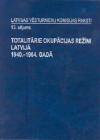 |
Totalitārie
okupācijas režīmi
Latvijā 1940.–1964. gadā: Latvijas vēsturnieku komisijas
2003. gada pētījumi [Totalitarian occupation regimes in Latvia in
1940-1964. Research of the Commission of the Historians of Latvia 2003].
–
Rīga: Latvijas vēstures institūta apgāds, 2004. – 581 lpp.
(Latvijas Vēsturnieku komisijas raksti, 13. sēj.).
Papers in Latvian or German, with summaries in Latvian, English or
German.
CONTENTS
Preface.
– P. 9.
SOVIET OCCUPATION IN LATVIA
(1940–1941)
Irēne Šneidere
The
First Soviet Occupation Period in Latvia: A few aspects. – P.
13.
Heinrihs
Strods
The Second Phase of the Soviet Occupation
of Latvia (early 1940 – mid-1941). – P. 26.
Dzintars Ērglis,
Irēne
Šneidere, Rudīte Vīksne, Arturs Žvinklis
Soviet
Repressions in Latvia in June–August 1940: Structural
Analysis. – P. 99.
Jānis
Stradiņš
Reprisals
of Totalitarian Occupation Regimes Against Science and Academic Circles
in Latvia (1940–1945). – P. 130.
Valters
Ščerbinskis
Destinies
of Academic Life Organisations of Latvia and Their Members during World
War II (1940–1945). – P. 165.
NAZI
GERMANY OCCUPATION IN LATVIA (1941–1945)
Antonijs Zunda
Nazi
German Occupation Policy in Latvia from the Perspective of the Soviet
Historiography. – P. 189.
Juris Pavlovičs
The
Change of Occupying Powers in Latgale During Summer 1941. –
P. 210.
Uldis
Neiburgs
Nazi-Occupied Latvia as Perceived by the
Western Allies (1941–1945). – P. 257.
Edvīns Evarts
Die
Reprivatisierungsfrage während der deutschen Okkupation
1941–1944. – P. 287.
Ēriks Jēkabsons
The
Social and Political Activities of Ethnic Belorussians in Latvia under
the Nazi German Occupation in 1941–1945. – P. 306.
Kārlis Kangeris
Die
Teilnahme von lettischen Schutzmannschafts-Bataillonen an den grossen
Partisanen Bekämpfungsaktionen 1942 und 1943. – P.
332.
Björn
Michael Felder
Das
Unternehmen “Wildkatze”. Der SS-Jagdverband Ost und
die
Vorbereitung von antisowjetischen Partisanen in Lettland
(1944–1945). – P. 358.
SOVIET
OCCUPATION IN LATVIA FROM 1944 TILL THE MID-60s
Aleksandrs Ivanovs
Soviet
Latvian Historiography on Sovietisation of Latvia in
1944–1956. – P. 389.
Ilgvars Butulis
Einige
Aspekte der sowjetischen Kulturpolitik in sowjetlettischen
Presseausgaben (1945–1949). – P. 427.
Ritvars Jansons
Interrelation
of Totalitarian Repressive Institutions and Their Role in the Local
Government of the Latvian SSR (1945–1959). – P. 442.
Daina Bleiere
People’s
Judges’ and Prosecutors’ Offices Functioning in the
Rural
Districts of Latvia (1944–1953). – P. 489.
Jānis
Riekstiņš
Erstrebungen
der deportierten Bürger Lettlands nach
Zurückgewinnung des verlorenen Eigentums. – P. 510.
Aldis Bergmanis,
Indulis Zālīte
Most
important Directions of Activities of the KGB of the Latvian SSR during
1960–1964. – P. 537.
The
Authors of the Articles Published in this Symposium. – P. 580.
|
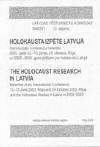 |
Holokausta
izpēte Latvijā: Starptautisko konferenču materiāli, 2003. gada
12.–13. jūnijs, 24. oktobris, Rīga, un 2002.–2003.
gada
pētījumi par holokaustu Latvijā [The holocaust research in Latvia.
Materials of an International Conference 12-13 June 2003, Rīga and 24
October 2003, Rīga and the Holocaust Studies in Latvia in 2002-2003].
– Rīga: Latvijas vēstures institūta apgāds, 2004. –
415 lpp. (Latvijas Vēsturnieku komisijas raksti, 12. sēj.).
Papers in Latvian or English, with summaries in English or Latvian.
CONTENTS
Preface.
– P. 9.
Opening Address of the President of the
Republic of Latvia Vaira Vīķe-Freiberga. – P. 12.
REPORTS
OF THE CONFERENCE “LATVIA UNDER NAZI GERMAN
OCCUPATION” ON
12 JUNE 2003 AND REPORTS OF THE CONFERENCE “THE HOLOCAUST
RESEARCH CONTINUES" ON 24 OCTOBER 2003
Aivars Stranga
Problems
in the Holocaust Research. – P. 17.
Marģers Vestermanis
“Riga-Kaiserwald”
Concentration Camp (A few aspects of the camp’s history).
– P. 32.
Rudīte
Vīksne
Extermination of Jews in Latvian Towns:
Problems and Results of Research. – P. 41.
Ārons
Šneijers
Holocaust
in Ludza: Jews and People of Other Nationalities. – P. 49.
Dzintars Ērglis
The
Holocaust and Expropriation of Jewish Property in Krustpils.
– P. 60.
Peter
Klein
How to Run Ghetto: Municipal Administration
in Occupied Riga and Lodz and the “Final Solution”.
– P. 82.
Anatoly
Podolsky
Problems
of Collaboration and Rescuing Jews on Latvian and Ukrainian Territories
During Nazi Occupation: An Attempt at Comparative Analysis. –
P.
87.
Kārlis
Kangeris
Dokumente des Dritten Reichs
über die Situation der Juden in Lettland von Juni 1940 bis
Juni 1941. – P. 93.
Josifs Ročko
Holocaust
in the Mind of Contemporary Society. – P. 106.
Dzintars Ērglis
The Destiny of the
Jewish
Community of Dundaga Parish, Ventspils District, in Summer 1941.
– P. 112.
Arturs
Žvinklis
Photo and Film Documents on the
Holocaust in Latvia. – P. 164.
Aigars Urtāns
An
Insight into the Holocaust Research in Bauska, Valmiera and Ludza
Districts. – P. 187.
Meijers Melers
Jewish
Mass Graves and Cemeteries in Latvia. – P. 196.
THE
ISSUES OF THE HOLOCAUST RESEARCH IN LATVIA
Aivars Stranga
Holocaust
in Latvia: 1941–1945. – P. 209.
Aigars Urtāns
Murder
of Jewish Civilians in the Provinces of Latvia (on the Example of Ludza
District). – P. 225.
Ēriks Prokopovicčs,
Andis
Jākabsons
Liquidation of Jews in Valdemārpils,
Talsi District, in Summer 1941. – P. 255.
Uldis Lasmanis
Extermination
of the Jewish Community in Nairi (Holocaust in Jaunjelgava).
– P. 278.
Irēne
Šneidere
Investigation Methods Used
Against Jews Arrested at the Beginning of 1953. – P. 358.
TESTIMONY
OF A HOLOCAUST SURVIVOR
Daisy Brand-Schweiger
Memories
of the Deportation of Hungarian Jews to Latvia in Summer. –
P. 379.
COLLECTION OF REGIONAL STUDIES
Jakov Karasin
Beginning
of World War II and Nazi Occupation Period. – P. 387.
The
Authors of the Articles Published in this Collection. – P.
414.
|
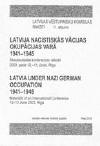 |
Latvija
nacistiskās Vācijas okupācijas varā, 1941–1945:
Starptautiskās
konferences referāti, 2003. gada 12.–13. jūnijs, Rīga
[Latvia under Nazi German occupation 1941-1945. Materials of an
International Conference 12-13 June 2003, Riga]. – Rīga:
Latvijas vēstures
institūta apgāds, 2004. – 229 lpp. (Latvijas Vēsturnieku
komisijas raksti, 11. sēj.).
Papers in Latvian or English, with summaries in Latvian, English or
German.
CONTENTS
Preface.
– P. 9.
Opening Address of the President of the
Republic of Latvia Vaira Vīķe-Freiberga. – P. 13.
1st
plenary session
NAZI GERMAN OCCUPATION POLICY IN LATVIA:
SOURCES AND HISTORIOGRAPHY
Antonijs Zunda
The
Policies of the German Occupation Rule in Latvia (1941–1945):
Opinions in Historiography. – P. 17.
Dmitrijs Oļehnovičs
Caricature
as a “Weapon of War”: Some Tendencies in Nazi
Propaganda. – P. 30.
Irēna Saleniece
Wehrmacht
Soldiers in the Memory of the People of Latvia (according to oral
sources of history). – P. 40.
Uldis Neiburgs
US
Intelligence Service OSS (Office of Strategic Services) and Its
Documents on Latvia in the Period of Nazi Occupation
(1941–1945).
– P. 48
2nd plenary session
NAZI
OCCUPATION POLICY IN LATVIA: PROBLEMS AND TASKS OF RESEARCH
Inesis Feldmanis
Nazi
Occupation Policy in Latvia (1941–1945): Current Problems of
Research and Solutions. – P. 59.
Heinrihs Strods
Extermination
of Activists and Supporters of the First Bolshevik Occupation in
1941–1945. – P. 72.
Kārlis Kangeris
Estlands
Selbstverwaltung vor der Reform der landeseigenen Verwaltungen
(07.03.1942) – Betrachtungen vom lettischen Standpunkt.
–
P. 83.
Edvīns
Evarts
Economic Policy of the German Occupation
Rule in Latvia during World War II. – P. 100.
Juris Pavlovičs
The
Specifics of the Change of Occupying Powers in Liepāja and Its
Environs: Analysis of Warfare Factors. – P. 108.
3rd
plenary session
LATVIA DURING THE YEARS OF WORLD WAR II:
COLLABORATION, RESISTANCE, PUBLIC OPINION AND EXTERNAL FACTORS
Andrievs Ezergailis
Collaboration
in German Occupied Latvia: Offered and Rejected. – P. 119.
Alexander Kokurin
The
Basic Activity Directions of the People’s Commissariat on
Internal Affairs of the Latvian Soviet Socialist Republic in
1940–1941. – P. 141.
Robert G. Waite
Some
Aspects of Anti-German Sentiment in Latvia (1941–1944).
– P. 154.
Katrin
Reichelt
The Role of Latvia’s
Independence Day, 18th November, in Nazi Occupation Policy,
1941–1943. – P. 177.
Mats Deland
The
Swedish–Latvian Relief Committee, German–Baltic and
Swedish
Intelligence and Impact on the Reception of War Criminals in Sweden.
– P. 188.
Jouko
Talonen
The Latvian Evangelical-Lutheran Church
during the German Occupation in 1941–1945. – P. 197.
Björn Michael
Felder
SS Jagdverband Ost
(1944–1945): A Case Study. – P. 221
The
Authors of the Articles Published in this Collection. – P.
228.
|
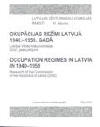 |
Okupācijas
režīmi Latvijā
1940.–1959. gadā: Latvijas Vēsturnieku komisijas 2002. gada
pētījumi [Occupation regimes in Latvia in 1940-1959. Research of the
Commission of the Historians of Latvia (2002)]. – Rīga:
Latvijas vēstures institūta apgāds, 2004. – 605 lpp.
(Latvijas Vēsturnieku komisijas raksti, 10. sēj.).
Papers in Latvian with summaries in English or German.
CONTENTS
Preface.
– P. 9.
SOVIET OCCUPATION IN LATVIA
(1940–1941)
Heinrihs Strods
The
First Period of Latvia’s Occupation (23 August 1939
– beginning of 1940). – P. 13.
Danute Dūra, Ieva
Gundare
Occupation
Powers and Latvian People: Changes in Popular Psychological Disposition
(1940–1941). – P. 88.
NAZI
GERMANY OCCUPATION IN LATVIA (1941–1945)
Juris Pavlovičs
Change
of Occupying Powers in Northern Kurzeme in Summer 1941. – P.
143.
Uldis
Neiburgs
Portrayal
of the Western Allies in Nazi-Occupied Latvia: Official Propaganda and
Disposition of Society (1941–1945). – P. 169.
Antonijs Zunda
Resistance
Movement in German-Occupied Latvia: Attitudes in Historical Literature.
– P. 216.
Ēriks
Jēkabsons
Polish National Resistance Movement in
Latvia during the German Occupation (1941–1944). –
P. 240.
Kārlis
Kangeris
Die
“Grosswerbung” für die lettischen
Schützmannschafts-Bataillone vom Februar bis September 1942
– die zweite Phase des Aufbaus der lettischen
Polizei-Bataillone.
– P. 277.
Inesis
Feldmanis
Lettische
und andere nichtdeutsche Waffen – SS Einheiten im Zweiten
Weltkrieg: Formierungsart, Ideologie und Kampfzwecke. – P.
334.
Edvīns
Evarts
Wirtschaftspolitik
der Nationalsozialisten in Lettland während deutscher
Besetzung im
historischen Überblick. – P. 352.
SOVIET
OCCUPATION IN LATVIA FROM 1944 TILL THE END OF THE 1950s
Aldis Bergmanis, Indulis Zālīte
Repressive
System of Occupation: Activities of the State Security Committee in the
Latvian Soviet Socialist Republic (1953–1959). – P.
373.
Zigmārs
Turčinskis
The Formation and
Beginning of
the Activities of the NPUL: October 1944 – March 1945.
– P. 433.
Ritvars
Jansons
Suppression of the Armed Resistance
Movement before Deportation of 1949 in Latvia. – P. 483.
Daina Bleiere
Resistance
of Farmers to the Soviet Policies in Latvia (1945–1953).
– P. 509.
Richards
Pētersons
Protection
of Cultural Monuments during the Soviet Occupation in the Latvian SSR
(first post-war decade, 1944–1953). – P. 554.
Jānis
Riekstiņš
Befreiung
der deportierten Einwohner Lettlands von der Sonderansiedlung
(1953–1959). – P. 576.
The
Authors of the Articles Published in this Symposium. – P. 605.
|
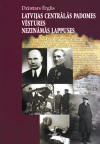 |
Ērglis
Dz. Latvijas
Centrālās padomes vēstures nezināmās lappuses [The Unknown Pages of the
History of the Central Council of Latvia]. –
Rīga: Latvijas vēstures institūta apgāds, 2003. – 231 lpp.,
il.
In Latvian with summary in English.
|
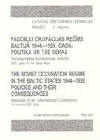 |
Padomju
okupācijas režīms Baltijā 1944.–1959. gadā: politika un tās
sekas: Starptautiskās konferences materiāli, 2002. gada
13.–14.
jūnijs, Rīga [The soviet occupation regime in the Baltic states
1944-1959: Policies and their consequences. Materials of an
International conference 13-14 June 2002, Riga]. – Rīga:
Latvijas vēstures institūta apgāds, 2003. – 462 lpp.
(Latvijas Vēsturnieku komisijas raksti, 9. sēj.).
Papers in Latvian, Russian or English, with summaries in Latvian or
English.
CONTENTS
Preface.
– P. 11.
Opening Address by President of the
Republic of Latvia Vaira Vīķe-Freiberga. – P. 21.
1st
plenary session
THE SOVIET OCCUPATION REGIME IN THE BALTIC
STATES (1944–1959): PROBLEMS OF METHODOLOGY, TERMINOLOGY AND
SOURCE-STUDIES
Irēne Šneidere
The
Soviet Occupation Regime in Latvia: Directions and Problems of
Research. – P. 25.
Heinrihs Strods
Occupation
of the Baltic States. A View on Terminology, Periodization, and the
Status of Research. – P. 35.
Erwin
Oberländer
Instruments
of Sovietization in 1939/40 and after 1944/45. – P. 50.
Alexander Ivanov
Historical
Science as a Tool of Soviet Policy: the Conceptual Level of
Historiography. – P. 59.
Aigi Rani
Project
“A Joint Register of Estonian Population Losses”:
Sources and Methods of Research. – P. 71.
2nd
plenary session
THE STRUCTURE OF THE POLITICAL POWER OF THE
SOVIET OCCUPATION REGIME
Daina Bleiere
The
Corps of Judges and Prosecutors in 1940–1941 and
1944–1953. – P. 83.
David Feest
Dealing
with the Unruly Reality: Rural Party Workers in Estonia
(1944–1950). – P. 93.
Aldis Bergmanis
Political
Changes in the Soviet Latvia in 1953. – P. 109.
Gatis Karlsons
Latvian
Sailors: History of Employment Restriction (1945–1953).
– P. 119.
3rd plenary session
THE
REPRESSIVE POLICIES OF THE SOVIET OCCUPATION REGIME IN THE BALTIC
STATES AND THEIR CONSEQUENCES
Arvydas Anušauskas
Crimes
of Communism in Lithuania (1944–1953): A
Historical-Statistical Survey. – P. 141.
JānisRiekstiņš
The
Deportation of 25 March 1949 in Latvia. – P. 162.
Arturs Žvinklis
Repressions
Against the Parliamentarians of the Republic of Latvia After World War
II. – P. 170.
Alexander
Kokurin
The
Prisons of the NKVD–KGB – People’s
Commissariat of
the Internal Affairs of Latvia, Lithuania, Estonia in
1944–1953.
– P. 185.
Ainārs
Bambals
Personal Files of the Officers of the
LSSR SSM Exterminators Battalions as a Source of History. –
P. 193.
Jaak
Pihlau
Escapes from Occupied Estonia
(1947–1959). – P. 203.
4th
plenary session
THE ECONOMIC AND SOCIAL POLICIES OF THE SOVIET
OCCUPATION REGIME IN THE BALTIC STATES, THEIR MANIFESTATIONS AND
CONSEQUENCES
Raita Karnīte
The
Latvian Economy 1944–1959: Economic Policies, their
Expression and Consequences. – P. 215.
Olaf Mertelsmann
Did
Estonian Industry Really Grow so Fast after the War? Soviet Statistics
and a More Realistic Approach. – P. 232.
Gunārs
Baltiņš
The
Specifics of the Methods of Statistics during the Soviet Period.
– P. 243.
Pēteris
Zvidriņš, Edvīns Vītoliņš
The
Demographic Losses and Changes of the Ethnic Structure in Latvia:
1944–1959. – P. 248.
Pārsla Eglīte
Demographic
Consequences of the Soviet Occupation in Latvia. – P. 256.
5th
plenary session
THE CULTURAL, EDUCATIONAL AND RELIGIOUS
POLICIES OF THE SOVIET OCCUPATION REGIME IN THE BALTIC STATES AND THEIR
CONSEQUENCES
Riho Altnurme
Soviet
Religious Policy towards the Lutheran Church in Estonia
(1944–1949) and its Consequences. – P. 269.
Arunas Streikus
The
Lithuanian Catholic Church and the Soviet Regime in
1944–1953. – P. 278.
Elīza Zikmane
Relations
between the Evangelical Lutheran Church of Latvia and the State
(1944–1959). – P. 287.
Irēna Saleniece
Implementing
Some Aspects of the Soviet Education Policy in Daugavpils
(1944–1953). – P. 299.
Jana Dreimane
The
People’s Libraries of Riga between the Interests of the State
Power and Society (1944–1953). – P. 311.
Aina Štrāle
Libraries
as Captives of the Soviet Ideology (1944–1953). –
P. 319.
Richards
Pētersons
The Policy of the Soviet Occupation
Power towards the Protection of Monuments (1944–1953).
– P. 331.
6th plenary session
ARMED
AND PEACEFUL RESISTANCE AGAINST THE SOVIET OCCUPATION REGIME IN THE
BALTICS
Ritvars Jansons
Latvian
Armed Resistance Movement (1944–1956): Historiography and the
Directions for Future Studies. – P. 343.
Heinrihs Strods
National
Partisans in the Baltic (1944 – January 1947): Armament,
Staffing, Military Action. – P. 358.
Zigmārs Turčinskis
The
Co-operation between Latvian and Estonian National Partisans
(1945–1952). – P. 382.
Alexander Daniel
Baltic
Resistance Movement in the Russia’s SAMIZDAT Human Rights
Periodicals (1960–1980). – P. 391.
7th
plenary session
THE BALTIANS (LATVIANS, LITHUANIANS,
ESTONIANS) IN THE FREE WORLD AND THE SOVIET OCCUPATION REGIME
Elmārs Pelkaus
The
Idea of the Independent Statehood of Latvia in the Period of Refugee
Camps (1944–1949). – P. 403.
Dzintars Ērglis
Attempts
to Resume the Work of the Central Council of Latvia and Arrests of its
Members after the Annihilation of the Council in 1945. – P.
414.
Kārlis
Kangeris
The Latvian Question in the Context of
Swedish-Soviet Relations (1941–1959). – P. 427.
Valters Nollendorfs
Exile
Historical Consciousness as Reflected in Literature: the Image of
Enemy, Hero, Sufferer and Friend. – P. 440.
Conclusions
and the Resolution. – P. 453.
|
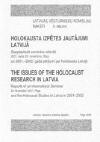 |
Holokausta
izpētes jautājumi
Latvijā: Starptautiskā semināra referāti, 2001. gada 29. novembris,
Rīga, un 2001 [The Issues of the holocaust research in Latvia. Reports
of an International Seminar 29 November 2001, Rīga and the Holocaust
Studies in Latvia in 2001-2002].–2002.
gada pētījumi par holokaustu Latvijā. – Rīga: Latvijas
vēstures
institūta apgāds, 2003. – 414 lpp. (Latvijas Vēsturnieku
komisijas raksti, 8. sēj.).
Papers in Latvian or English, with summaries in Latvian, German or
English.
CONTENTS
Preface.
– P. 9.
Address to the Participants of the Seminar
by President of the Republic of Latvia Vaira Vīķe-Freiberga.
– P. 11.
REPORTS OF THE SEMINAR
Aivars Stranga
The
Contribution of the Historians’ Commission of the President
of
Latvia to the Research into the Issues of the Holocaust. – P.
15.
Andrievs
Ezergailis
Rumbula: A Perspective on the
Perception of the Holocaust. – P. 24.
Wolfgang Scheffler
The
Fate of the German Jews in the Ghetto of Riga and Surroundings. A Short
Survey. – P. 39.
Kārlis
Kangeris
Die lettisch-judischen Beziehungen aus
der Sicht des Dritten Reiches (1933-1939). – P. 52.
THE
ISSUES OF THE HOLOCAUST RESEARCH IN LATVIA OF THE YEAR 2001
Rudīte Vīksne
The
Liquidation of Jews in Ventspils, 1941. – P. 67.
Rudīte Vīksne
The
Destruction of Auce Jews, July 1941. – P. 101.
Dzintars Ērglis
The
Murdering of the Jews in Krustpils. – P. 127.
Dzintars Ērglis
Enteignung
jüdischen Eigentums in Kreuzburg während der Zeit der
nationalsozialistischen Besatzung. – P. 158.
Grigorijs Smirins,
Meijers Melers
The
Tragedy of Jewish People in the Latvian Countryside during the
Holocaust in the Summer of 1941 (Silene, Gostiņi, Malta). –
P.
210.
Aigars
Urtāns
Several Aspects and Problems of Holocaust
Studies in Bauska Town and District. – P. 235.
Aigars Urtāns
Assassination
of Jewish Civilians in the Valmiera District (Summer-Autum 1941).
– P. 253.
Katrin
Reichelt
Between
Collaboration and Resistance? The Role of the Organization
“Pērkonkrusts” in the Holocaust in Latvia.
– P. 279.
Juris
Pavlovičs
Change of Occupying Powers in the
District of Valmiera in Summer 1941. – P. 299.
Rudīte Vīksne
The
Killing of the Deseased During the German Occupation, 1941-42.
– P. 324.
Aigars
Urtāns
Destruction of Gipsies of Bauska Town and
Region in Summer 1942. – P. 351.
Irēne
Šneidere
Political
Persecution of Latvian Jews: 1948-1953. – P. 359.
TESTIMONIES
OF THE SURVIVORS
Judith Himmelfarb (Telaviv). – P.
384.
Israel Rivkovich (Jerusalem). – P. 402.
COLLECTION
OF REGIONAL STUDIES
On the Fate of Jews of Pāvilosta and the
Local Jewish Cemetery During the Holocaust. – P. 411.
The
Authors of the Articles Published in this Collection. – P.
414.
|
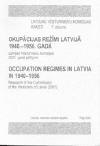 |
Okupācijas
režīmi Latvijā
1940.–1956. gadā [Occupation regimes in Latvia in 1940-1956.
Research of the Commission of the Historians of Latvia (2001)]. –
Rīga: Latvijas vēstures institūta apgāds, 2002. – 495 lpp.
(Latvijas Vēsturnieku komisijas raksti, 7. sēj.).
Papers in Latvian, with summaries in English or German.
CONTENTS
Preface.
– P. 9.
SOVIET OCCUPATION IN LATVIA IN
1940–1941
Irēne
Šneidere
Arrested in June –
Beginning of July, 1941: Fate of the Civilians of Latgale in the Gulag
Camps. – P. 15.
Ilga
Kreituse
Collaborationism
in Latvia during the First Months of the Soviet Occupation and
Annexation (June–August 1940): A Proposition. – P.
35.
Lelde Ozola
Materials
and Documents of the LC(b)P on Represive Activities of the Soviet
Occupation Regime (June 1940 – June 1941). – P. 57.
Danute Dūra, leva
Gundare,
Dzidra Zujeva
Occupation Powers and Latvian
Society: From the Viewpoint of the ‘National Watch’
Collection. – P. 80.
NAZI GERMANY
OCCUPATION IN LATVIA (1941–1945)
Jānis Taurēns
Latvia
during the German Occupation through the Eyes of Western Historians.
– P. 107.
Edvīns
Evarts
Deutsche Historiker über die
nationalsozialistische Okkupationspolitik Deutschlands in Lettland.
– P. 123.
Antonijs
Zunda
Collaboration in the German-occupied
Latvia: Assessments in Historical Literature. – P. 141.
Inesis Feldmanis
Lettische
und andere undeutsche Waffen-SS-Einheiten im Zweiten Weltkrieg:
Gemeinsames und Unterschiedliches. – P. 165.
Ēriks Jēkabsons,
Uldis Neiburgs,
Kaspars Zellis
The Activities of Latvian Soldiers
in Poland under the German Military Service (1942–1945).
– P. 179.
SOVIET OCCUPATION IN LATVIA FROM
1944 TILL THE MID-50S
Inese
Dreimane
Participation of Christian Priests of
Latvia in the National Resistance Movement (1944–1953).
– P. 221.
Zigmārs
Turčinskis
National Partisans in Northern
Vidzeme: 1945–1953. – P. 285.
Daina Bleiere
The
Legal System (the Corps of Judges and Public Prosecutors) in 1940-1941
and 1944-1953. – P. 368.
Pārsla Eglīte,
Ilmārs Mežs
Colonization
of Latvia and Changes in Ethnic Composition of Its Population
(1944-1990). – P. 405.
Jānis
Riekstiņš
Vorrechte
der Einwanderer in der Verteilung von Wohnungen in Lettland
(1941-1956). – P. 444.
The Authors of the
Articles Published in this Symposium. – P. 494.
|
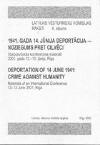 |
1941.
gada 14. jūnija deportācija – noziegums pret cilvēci:
starptautiskās konferences materiāli, 2001. gada 12.–13.
jūnijs,
Rīga [Deportation of 14 June 1941: crime against humanity. Materials of
an international Conference 12-13 June 2001, Riga]. –
Rīga: Latvijas
vēstures institūta apgāds, 2002. – 415 lpp. (Latvijas
Vēsturnieku komisijas raksti, 6. sēj.).
Papers in Latvian or English, with summaries in Latvian or English.
CONTENTS
Preface.
– P. 11.
Opening Address of the President of the
Republic of Latvia Vaira Vīķe-Freiberga. – P. 15.
1st
plenary session
DEPORTATION OF 14 JUNE 1941: CRIME AGAINST
HUMANITY
Jānis
Riekstiņš
The Deportation of 14 June
1941 in Latvia. – P. 21.
Arvydas
Anušauskas
Deportations
– Crime Against Humanity: Comparative Analysis. –
P. 35.
Indulis
Zālīte, Sindija Eglīte
Structural Analysis of the
Deportation of 14 June 1941. – P. 40.
Natalya Lebedeva
The
Deportation of the Polish and Baltic Population to the USSR in
1939–1941: Common and Peculiar. – P. 51.
Pavel Polian
Deportation
of 14 June 1941 in the Context of the Soviet Deportation Policy.
– P. 72.
Zinaida
Sytnic
The Drama of Deportations from Bessarabia:
the Mechanism of Terror’s Machinery. – P. 74.
Steven Springfield
Deportation
of 1941 and Its Effects on the Jewish Community in Latvia. –
P. 77.
2nd plenary session
DEPORTATION OF
14 JUNE 1941 IN THE INTERNATIONAL AND LEGAL CONTEXT
Andrejs Lepse
Deportation
of 14 June 1941 in the International Context. – P. 89.
Robert G. Waite
The
United States and Soviet Occupation of Latvia, 1940–1941.
– P. 103.
Kalju
Mätik
Compensation of Crimes of the
Occupants. – P. 122.
Linards
Muciņš
Legal
Rehabilitation of the Repressed Persons in Latvia after 1990, Its
Results and Prospects. – P. 128.
Alfred Erich Senn
Soviet
Rule in Lithuania, 1940–1941. – P. 135.
Inga Petravičiūtė
Soviet
Repressive Structures and Collaboration with Them in Lithuania in
1940–1941. – P. 140.
Anatoly Rusnachenko
Deportations
from the Western Ukraine in 1939–1941. – P. 149.
Kārlis Kangeris
The
Soviet Occupation and the Deportation of 14 June in the Propaganda of
the National Socialistic Germany Occupation Power to Follow
(1941–1942). – P. 154.
Dov Levin
Mass
Deportation of Latvian Jews to Remote Areas of the USSR: June 1941.
– P. 175.
3rd plenary session
SOCIAL,
ETHNIC, TERRITORIAL ASPECTS AND DEMOGRAPHIC CONSEQUENCES OF THE
DEPORTATION OF 14 JUNE 1941
Ainārs Lerhis
The
Fate of the Employees of the Latvian Ministry of Foreign Affairs in the
Soviet Camps. – P. 191.
Arturs Žvinklis
Soviet
Repressions against the Parliamentarians of the Republic of Latvia in
1940–1941. – P. 201.
Ēriks Jēkabsons
14
June 1941 in the 24th Territorial Riflemen Corps of the Red Army.
– P. 224.
Irēne
Šneidere
The Fate of Latgale Civilians
in the Camps and Prisons after the Arrest on 22 June–4 July
1941. – P. 236.
Uldis
Lasmanis
Repressions of 1941 in Jēkabpils
District. – P. 261.
Dzintars Ērglis
14
June 1941 in Dundaga Pagasts of Ventspils District. – P. 269.
Iveta Šķiņķe
The
Women Arrested and Exiled During the Deportation of 14 June 1941: an
Insight into the Problem. – P. 331.
Pēteris
Šķiņķis
The
Impact of Deportations on the Development of Latvian Rural Society.
– P. 343.
Pēteris
Zvidriņš, Edvīns Vītoliņš
Direct
and Indirect Demographic Consequences of the Deportation of 14 June
1941. – P. 359.
4th plenary session
PROBLEMS
OF HISTORY SOURCE-STUDIES OF THE DEPORTATION OF 14 JUNE 1941
Elmārs Pelkaus
The
Reflection of the Deportation of 1941 in the Documents of the Communist
Party of Latvia. – P. 367.
Ainārs Bambals
Archive
Materials on the Cases of Inhabitants of Latvia Deported on 14 June
1941 as a Source of History. – P. 373.
Elga Zālīte
Demonizations
and Deportations: Propaganda Wars in Latvia, 1941. – P. 384.
Naum Lifshits
The
Deportation of 14 June 1941 as Part of the Soviet Holocaust.
– P. 406.
CONCLUSIONS AND RESOLUTION.
– P. 411.
|
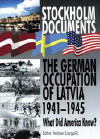 |
Stockholm
Documents. The German Occupation of Latvia. 1941–1945: What
Did
America Know? – Riga: Publishers of the Historical Institute
of
Latvia, 2002. – XX+507 p. (Symposium of the
Commission of the Historians of Latvia, Vol. 5).
In English.
This volume is
dedicated to those who during the Second World War fought for Latvia by
spying for the Western democracies.
The
documents in this volume come from the Records of the United States
Department of State relating to the Internal Affairs of Latvia,
1920–1945. The documents are important:
1) for what
they say about Latvia under the Nazis;
2) for what they tell
us about Latvian resistance against the Nazis; and
3) for what
they tell us about American knowledge of Latvia during the German
occupation.
CONTENTS:
Conditions in Nazi
Occupied Latvia: Voldemārs Salnais’ Reports
Stockholm
Intercepts: Radio Reports from Rīga, 1942(IX)–1945(I)
Legal
Status of Latvia
Culture, Society, Economy
Fēliks
Cielēns’ Reports, 1944
Memoranda, Notes, Dispatches
CONTENTS
Introduction.
– IX. lpp.
Part One. VOLDEMĀRS SALNAIS
REPORTS. 1941–1944. – 1. lpp.
1. First Year of the
German
Occupation, 1942. – 3. lpp.
Contents. – 3.
lpp.
2. Latvia in the Autumn of 1942. – 110. lpp.
3.
Latvia at the Turn of the Year 1942–1943. – 121.
lpp.
4. Latvia in August 1943. – 149. lpp.
5.
Latvia in March 1944. – 178. lpp.
Part
Two. RĪGA RADIO REPORTS. Stockholm Intercepts. – 185. lpp.
Rīga Radio Reports,
1942.
– 187. lpp.
Rīga Radio Reports, 1943. –
201. lpp.
Rīga Radio Reports, 1944/45. – 260. lpp.
Part
Three. THE LEGAL STATUS OF LATVIA. – 333. lpp.
1. The Opinion of
Three Latvian
Lawyers. – 335. lpp.
2.
Minutes of Conference Held on January 29, 1943 between Leaders of the
Latvian “Self-Government” and of the General
Commissariat.
– 343. lpp.
3. Mobilization Order
Issued by
German Authorities, February 13, 1943. – 350. lpp.
4.
Extension of Rights of Latvian and Estonian
“Puppet” Governments. – 354. lpp.
5.
Identification Cards in the Occupied Eastern Areas. – 359.
lpp.
6. Memorandum to Himmler. – 362. lpp.
Part
Four. CULTURE. SOCIETY. ECONOMY. – 367. lpp.
1. Conditions at the
University
of Rīga under the Soviet and German Occupations. – 369. lpp.
2.
The Church in Latvia during Soviet Russian and German Rule. –
374. lpp.
3. Labor Situation in Latvia in 1943 and 1944.
– 384. lpp.
4. Textiles and Wool. – 402.
lpp.
5. Farm Economy. – 407. lpp.
Part
Five. FĒLIKS’S CIELĒNS’S REPORTS. – 417.
lpp.
1. The
Struggle of the Latvian People for National and Political Freedom.
– 419. lpp.
2. The Internal Political Situation in
Latvia at the End of the Fourth Year of Occupation. – 427.
lpp.
3. The Present Military and Political Situation in
Latvia. – 432. lpp.
4. Conditions in Latvia and the
Situation in Respect to Evacuees in Germany. – 439. lpp.
Part
Six. MEMORANDA. NOTES. DISPATCHES. 1941–1945. –
445. lpp.
1.
Alfrēds Bīlmanis: Conversations and a Letter. 1942–1944.
– 447. lpp.
2. News from Latvia.
1942–1944. – 451. lpp.
3. Latvian
Underground. – 462. lpp.
4. Francis Balodis
Lecture: The
Fate of Latvia. – 468. lpp.
5. Germans in Latvia by
A. Jablonskis. A Soviet View. – 471. lpp.
6. Bruno
Kalniņš and Alfrēds Bērziņš. – 475. lpp.
7.
Baltic Refugees in Sweden. – 478. lpp.
|
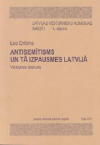 |
Dribins L.
Antisemītisms un tā
izpausmes Latvijā: Vēstures atskats [Anti-Semitism and its Expressions
in Latvia. History in Brief]. – Rīga: Latvijas
vēstures institūta apgāds, 2002. – 183 lpp. (Latvijas
Vēsturnieku komisijas raksti, 4. sēj.).
In Latvian with summary in English.
|
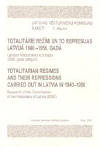 |
Totalitārie
režīmi un to
represijas Latvijā 1940.–1956. gadā: Latvijas Vēsturnieku
komisijas 2000. gada pētījumi [Totalitarian regimes and their
repressions carried out in Latvia in 1940-1956. Research of the
Commission of the Historians of Latvia (2000)].
– Rīga: Latvijas vēstures institūta apgāds, 2001. –
743 lpp. (Latvijas Vēsturnieku komisijas raksti, 3. sēj.).
Papers in Latvian with summaries in English or German.
CONTENTS
Preface.
– P. 9.
SOVIET OCUPATION IN LATVIA IN
1940–1941
Irēne
Šneidere
Repressions of the Soviet
Regime against the Civilians of Latgale: June – Beginning of
July, 1941. – P. 15.
Ēriks Jākabsons
Repressions
by the Soviet Rule against the Polish, Lithuanian and Belorussian
Population of Latvia in 1940–1941. – P. 51.
Ainārs Lerhis
The
Soviet Repressions against Diplomats of Independent Latvia. –
P. 71.
Ēriks
Jēkabsons, Ainārs Bambals
Annihilation of the
Latvian Army and Reprisals against Militaries in 1940–1941.
– P. 120.
NAZI GERMANY OCUPATION IN LATVIA
(1941–1945)
Inesis
Feldmanis
Latvia during German Occupation
(1941–1945): Topical Problems of Research. – P. 173.
Antonijs Zunda
The
Policies of the German Occupation Authorities in Latvia: Approaches in
the Historical Literature. – P. 186.
Jānis Taurēns
The
Baltic Question in the Policy of the Great Powers during World War II:
An Insight into Historiography. – P. 208.
Kaspars Zellis,
Uldis Neiburgs
Latvian
Population Repressed during the German Occupation
(1941–1945): Database. – P. 227.
Kārlis Kangeris
Repressive
Policies against Latvian Intelligentsia Planned by National-Socialistic
Germany in 1941–1942. – P. 240.
Uldis Neiburgs,
Dzintars Ērglis
National
and Soviet Resistance Movement – the Common and the Different
(1941–1945). – P. 267.
Dzintars Ērglis
The
Participants of the General Kurelis Group Arrested by the Soviet
Repressive Structures. – P. 330.
SOVIET
OCUPATION IN LATVIA FROM 1944 TILL THE MID-50S
Ritvars Jansons,
Indulis Zālīte
Establishment
of the State Security Institutions in the LSSR and Their Main
Repressive Aims (1944–1956). – P. 373.
Aldis Bergmanis
Development
of the LSSR National Security Institutions and Their Role in the
Genocide against the Latvian People (1944–1953). –
P. 477.
Daina
Bleiere
Repressions against Farmers in Latvia in
1944–1953. – P. 539.
Heinrihs Strods
National
Resistance Movement of Latvian Schoolchildren (1944 –
Mid-50s). – P. 592.
Jānis
Riekstiņš
Migrant
Colonization in Latvia (1944 – Mid-50s). – P. 676.
|
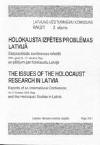 |
Holokausta
izpētes problēmas Latvijā: Starptautiskās konferences referāti, 2000.
gada 16.–17. oktobris, Rīga un pētījumi par holokaustu
Latvijā [The issues of the holocaust researh in Latvia. Reports of an
International Conference 16-17 October 2000, Riga and the Holocaust
Studies in Latvia]. – Rīga: Latvijas
vēstures institūta apgāds, 2001. – 407 lpp. (Latvijas
Vēsturnieku komisijas raksti, 2. sēj.).
Papers in Latvian or English, with summaries in Latvian, English or
German.
CONTENTS
Address
by President of the Republic of Latvia Vaira Vīķe-Freiberga.
– P. 9.
Alfred
Erich Senn
Studying World War II and the
Holocaust (remarks on the symposium). – P. 12.
REPORTS
OF THE CONFERENCE
Norman
Naimark
The Holocaust in Latvia in the Context:
Problems of Comparison and Historicization. – P. 19.
Aivars Stranga
The
Attitude of the Latvian Society towards the Holocaust. – P.
30.
Marģers
Vestermanis
The Holocaust in Latvia: A
Historiographic Survey. – P. 36.
Edward Anders,
Juris Dubrovskis
Fate
of Latvian Jews 1941–1945: Recovering Names from Official
Records. – P. 49.
Robert G. Waite
West
German Courts and the Holocaust in Latvia. – P. 61.
Peter Klein
Strategy
or Improvisation? The Ghetto of Riga as the Destination of Deportations
from Western Europe. – P. 74.
David Cesarani
Is
There, and Has There Ever Been, a “Holocaust
Industry”? – P. 83.
Irena Veisaite
The
Perception of the Holocaust in Lithuania. – P. 100.
Andrievs Ezergailis
Folklore
versus History: A Problem in Holocaust Studies. – P. 106.
Leo Dribins
Hysterics
of Anti-Semitic Ideology in the German Nazi Occupied Latvia in
1941–1942. – P. 121.
Dov Levin
Some
Basic Facts on Latvian Jewry – Before, During and After World
War II. – P. 134
Paul
A. Levine
Teaching the History of the Holocaust
in Different Countries: Problems and Possibilities. – P. 153.
Katrin Reichelt
Profit
and Loss: the Economic Dimensions of the Riga Ghetto
(1941–1943). – P. 169.
Tapani Harviainen
World
War II and Jews in Finland. – P. 185.
Kārlis Kangeris
Lettische
Schutzmannschafts-Bataillone: Stand und Aufgaben der Forschung.
– P. 195.
Svetlana
Bogojavļenska
Sheina Grama’s Diary
(Preiļi, July–August 1941) as a Historical and Human
Evidence. – P. 225.
Guntis
Dišlers
The
Attitude of Latvia’s Lutheran Church towards the Holocaust in
World War II. – P. 233.
Arturs Žvinklis
The
Fate of the Latvian State Officials of Jewish Origin in World War II.
– P. 248
Īzaks
Kleimanis
The Holocaust in Latvia. Echoes and the
Challenge. – P. 258.
THE ISSUES OF THE
HOLOCAUST RESEARCH IN LATVIA
Dzintars Ērglis
A
Few Holocaust Episodes in Krustpils: Beila Bella Weide Case.
– P. 269.
Aivars
Stranga
Jewish Refugees in Latvia
(1933–1940). – P. 299.
Irēne
Šneidere
Political
Trials against Jews in Latvia (1944–1952). – P. 328.
Rudīte Vīksne
The
Arājs’ Commando Member as Seen in the KGB Trial Files: Social
Standing, Education, Motives for Joining It, and Sentences Received.
– P. 350.
Marģers
Vestermanis
Announcement of research
“The Resistance to the Holocaust in Latvia”.
– P. 384.
The Authors of the Articles
Published in this Symposium. – P. 407.
|
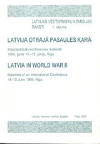 |
Latvija Otrajā
pasaules karā:
Starptautiskās konferences materiāli, 1999. gada 14.–15.
jūnijs, Rīga [Latvia in World War II. Materials of an International
Conference 14-15 June 1999, Riga]. – Rīga:
Latvijas vēstures institūta apgāds, 2000. – 391 lpp.
(Latvijas Vēsturnieku komisijas raksti, 1. sēj.).
Papers in Latvian or English, with summaries in English or Latvian.
CONTENTS
Preface.
– P. 11.
Opening Address by President of the
Republic of Latvia Guntis Ulmanis. – P. 15.
1st
plenary session
MOLOTOV–RIBBENTROP PACT AND ITS
CONSEQUENCES
Inesis
Feldmanis
Molotov–Ribbentrop Pact and
Latvia. – P. 19.
Erwin
Oberländer
Latvian–German
Relations, 1939–1940. – P. 35.
Aivars Stranga
The
USSR Policy in the Baltic Region (1938–1940). – P.
42.
Vadim
Roginsky
The
Baltic Tragedy. The Baltic States and Nations in the Politics of the
USSR and Nazi Germany on the Eve and During the World War II.
–
P. 49.
Dietrich
A. Loeber
Consequences of the
Molotov–Ribbentrop Pact Continuing into Our Days:
International Legal Aspects. – P. 67.
2nd
plenary session
COLLABORATION AND RESISTANCE MOVEMENT IN LATVIA
Kārlis Kangeris
Limiting
Possibilities: the “New Europe”, a Soviet Republic
or an
Independent State. National Law Matters and “Big
Politics”
During the War (1941–1945). – P. 79.
Irēne
Šneidere
The
First Year of the Soviet Occupation: Preconditions for Collaboration.
– P. 95.
Arvydas
Anušauskas
Collaboration
and Crimes to Humanity in the Occupied Baltic States in
1940–1941
Against the Background of World War II. – P. 107.
Robert G. Waite
“Reliable
Local Residents”: Collaboration in Latvia,
1941–1945. – P. 115.
Elmārs Pelkaus
German
Occupation Power and Latvian Politicians. – P. 145.
Dzintars Ērglis
Activities
of the Latvian Central Council in Latvia After the End of World War II.
– P. 154.
Uldis
Neiburgs
Organisations of National Resistance in
Latvia During the Soviet and German Occupation Period
(1940–1945). – P. 163.
Joke van der
Leeuw-Roord
Teaching
Sensitive Issues with Focus on World War II. – P. 173.
3rd
plenary session
MILITARY FORMATIONS DURING WORLD WAR II IN
LATVIA AND OTHER OCCUPIED COUNTRIES
Hannes Walter
Estonian
National Units in World War II in German and Finnish Armed Forces.
– P. 183.
Heinrihs
Strods
Soldiers of the Occupied Countries Under
Alien Colours. – P. 189.
Uldis Neiburgs
Latvian
Soldiers in the Armies of Germany and the USSR: Main Problems.
– P. 197.
Harold
Otto
Brīvprātīgi iesaukti: How the Germans
Conscripted “Volunteers” for the Latvian Legion.
– P. 208.
Anatoly
Rusnachenko
National
Liberation Movement in the Ukraine During World War II: Search for
Alternatives and Parallels with Latvia. – P. 215.
Wojciech Roszkowski
Defeat
in Victory: Polish War Efforts, 1939–1945. – P. 221.
4th
plenary session
CRIMES AGAINST CIVIL POPULATION IN LATVIA
DURING WORLD WAR II
Andrew
Ezergailis
The Role of the Self-Defense
Commandantures in the Holocaust. – P. 235.
Aleksey Litvin
The
Latvian Police Battalions in Byelorussia in 1941–1944.
– P. 252.
Katrin
Reichelt
Latvia and Latvians in the Nazi Race and
Settlement Policy: Theoretical Conception and Practical Implementation.
– P. 266.
Heinrihs
Strods
The Repeated Occupation of Latvia by the
Soviet Union (1944–1945). – P. 278.
Rudīte Vīksne
Repressions
Against the Latvian Population in 1940–1941 and
1944–1945: The Common and the Different. – P. 288.
Alexander Kokurin
Evacuation
of the Convicts from the Prisons of the Latvian SSR People’s
Commissariat of the Interior in 1941. – P. 295.
5th
plenary session
LATVIA IN WORLD WAR II: PROBLEMS OF
METHODOLOGY AND SOURCE STUDIES
Vilnis Zariņš
Latvia
Under Two Occupational Powers: Problems and Paradigms. – P.
305.
Roberts
Ķīlis
Methods of Social Anthropology in the
Research of Mass Cataclysms. – P. 321.
Mirdza Kate Baltais
Latvia
at the Tehran and Yalta Conferences – Issues and Sources.
– P. 330.
Luboš
Švec
The Archives of the Czech
Republic on Latvia During World War II. – P. 336.
Aija Kalnciema
Documents
of German Occupation Period in the Latvian Archives. – P. 342.
Arturs Žvinklis
Latvian
Press During the Period of Nazi Germany Occupation. – P. 353.
Leo Dribins
Anti-Semitism
in the Latvian Press Published During the Nazi Occupation Period
(1941–1945). – P. 360.
Martin C. Dean
Seizure,
Registration, Rental and Sale: the Strange Case of the German
Administration of Jewish Moveable Property in Latvia
(1941–1944).
– P. 372.
Valters
Nollendorfs
From Historical Facts to Historical
Awareness: Principles and Approaches of the Latvian Occupation Museum.
– P. 382.
The Authors of the Articles
Published in this Symposium. – P. 390.
|
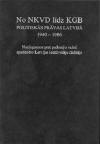 |
No
NKVD līdz KGB. Politiskās prāvas Latvijā 1940–1986:
Noziegumos
pret padomju valsti apsūdzēto Latvijas iedzīvotāju rādītājs
[From NKVD to KGB.
Political Trials in Latvia 1940–1986]/
Rudītes Vīksnes un Kārļa Kangera redakcijā. – Rīga: LU
Latvijas
vēstures institūta apgāds, 1999. – XVIII + 975 lpp.
In Latvian with summary in English.
|
|
|

